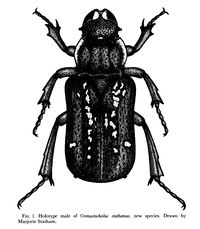Cremastocheilus stathamae
| Cremastocheilus stathamae | |
|---|---|

| |
| Scientific classification | |
| Kingdom: | Animalia |
| Phylum: | Arthropoda |
| Class: | Insecta |
| Order: | Coleoptera |
| Family: | Scarabaeidae |
| Subfamily: | Cetoniinae |
| Tribe: | Cremastocheilini |
| Genus: | Cremastocheilus |
| Subgenus: | Trinodia |
| Species: | C. stathamae |
| Binomial name | |
| Cremastocheilus stathamae Cazier, 1961 | |
One of about thirty-five species of myrmecophilous Cremastocheilus. The host ant is Myrmecocystus mexicanus and Myrmecocystus depilis.
Identification
Key to Trinodia species
Distribution
Arizona
Habitat
Common hosts are Myrmecocystus mexicanus and Myrmecocystus depilis.
Biology
Found emerging from the nest of Myrmecocystus species in August. After emergence from the ant host nest, beetles mate in sandy washes or sandy trails. Location for larval development is unknown.
Nomenclature
Description
MALE: Small size, slender, black above and beneath, legs dark reddish brown; clypeus, head, pronotum, elytra, meta-epistoma clothed with tomentose areas. Head coarsely punctate, punctures separated by less than half of their own widths, posterior margin deeply declivous, vertex with shallow, median impression, elongate tomentose area behind impression; canthus prominent, apex clothed with short, stout spines; clypeus same width as head including eyes, anterior margin strongly reflexed medially, shallowly laterally, strongly carinate medially, large white tomentose areas on each side of median carina, anterior margin and carina sparsely clothed with short hair, lateral surface almost impunctate, shining; mentum cupuleform, margin slightly produced posteriorly at middle. Pronotum wider than long, widest at anterior third, shallowly constricted before hind angles, hind angles prominent, slightly reflexed laterally, prominent pubescent area beneath; anterior angles shallowly emarginate, deeply impressed inside, anterior pro-episternal projection prominent, angles deeply incised laterally to pubescent areas; surface trilobed, lateral impressions shallow medially, very deep anteriorly, posteriorly strongly impressed, ending in deep pit inside posterior angles, shallowly, sparsely, irregularly punctate, punctures separated by about their own widths laterally, each puncture with a short brown hair near anterior margin of puncture, lateral margins with wide tomentose band extending from emarginate anterior angles to basal third, posterior margin broadly tridentate; scutellum acutely pointed apically, shallowly impressed, surface alutaceous, with five large setigerous punctures. Elytra one-third wider than pronotum, slightly wider at base, lateral margins shallowly sinuate behind humeral umbone, strongly reflexed downward, apices evenly rounded; surface irregular, slight elevations on each side of apex of scutellum, sutural margins strongly elevated medially, shallow but prominent lateral discal ridges at base, irregularly punctate, punctures usually elongate, some punctures united on disc, each puncture with short, brown, basal hair, subsutural impression with irregular row of irregularly placed tomentose spots, lateral discal ridge with large tomentose spot at apical third. Under surface sparsely, shallowly punctate, each puncture with short brown hair, surface shining; reflexed portion of metasternum tomentose; abdomen concave, first abdominal segment tomentose laterally, with narrow, tomentose, apical band complete, second segment with apical tomentose band extending to about lateral third, segments 3 and 4 with shorter tomentose bands; pygidium subcylindrical, slightly flattened dorsally, surface densely punctate above, sparsely punctate beneath; legs sparsely setigerously punctate, slightly flattened, anterior tibiae bidentate externally, middle tibiae shorter than femora, hind tibiae as long as femora, striately punctate, small tooth posterior to middle on outer edge; tarsi five-segmented. Length, 8 mm.; width, 3.5 mm.
References
- Alpert, Gary D. 1994. A Comparative Study of the Symbiotic Relationship Between Beetles of the Genus Cremastocheilus (Coleoptera: Scarabaeidae) and their Host Ants (Hymenoptera:Formicidae). Sociobiology 25(1).